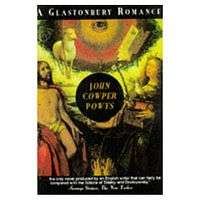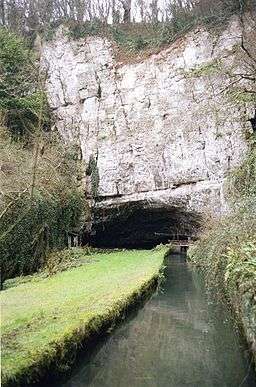A Glastonbury Romance
 | |
| Author | John Cowper Powys |
|---|---|
| Country | England |
| Language | English |
| Genre | Novel |
| Publisher | Simon & Schuster (US); The Bodley Head (UK) |
Publication date | 6 March 1932 |
| Media type | Print (Hardback & Paperback) |
| Pages | 1174 (1932, New York) |
| ISBN | 0-7156-3648-0 |
| OCLC | 76798317 |
| 823.912 | |
| LC Class | PR6031.O867 |
| Preceded by | Wolf Solent |
| Followed by | Weymouth Sands |
A Glastonbury Romance (1932) is the second of John Cowper Powys's (1873–1963) Wessex novels, along with Wolf Solent (1929), Weymouth Sands (1934) and Maiden Castle (1936). Powys was an admirer of Thomas Hardy and these novels are set in Somerset and Dorset parts of Hardy's mythical Wessex.[1] The first two chapters of A Glastonbury Romance takes place in Norfolk, where the late Canon William Crow's will is read, and the Crow family learn that his secretary-valet John Geard has inherited his wealth.[2] Also in Norfolk a romance begins between cousins John and Mary Crow. But after an important scene at the ancient monument of Stonehenge the rest of the action takes place in or near the Somerset town of Glastonbury. This is a few miles north of the village of Montacute, where Powys's father was a clergyman, and where Powys lived for much of his youth. The action occurs over roughly a year. The grail legends associated with the town of Glastonbury are of major importance in this novel.
Introduction and summary of the plot
In Powys's words this novel's "heroine is the Grail",[3] and its central concern is with the various myths and legends along with history associated with Glastonbury. It is also possible to see most of the main characters, John Geard, Sam Dekker, John Crow, and Owen Evans as undertaking a Grail quest. Not only is A Glastonbury Romance concerned with the legend that Joseph of Arimathea brought the Grail, a vessel containing the blood of Christ, to the town, but the further tradition that King Arthur was buried there. In addition one of the novels main characters, the Welshman Owen Evans, introduces the idea that the Grail has a Welsh (Celtic), pagan pre-Christian origin. The main sources for Powys's ideas on mythology and the Grail legend are Sir John Rhys's Studies in the Arthurian Legend, R. S. Loomis's Celtic Myth and Arthurian Romance, and the works of Jessie L. Weston, including From Ritual to Romance.[4] T. S. Eliot's The Waste Land is another probable influence. A central aspect of A Glastonbury Romance is the attempt by John Geard, ex-minister now the mayor of Glastonbury, to restore Glastonbury to its medieval glory as a place of religious pilgrimage. On the other hand, the Glastonbury industrialist Philip Crow, along with John and Mary Crow, and Tom Barter, who are like him are from Norfolk, view the myths and legends of the town with contempt. Philip's vision is of a future with more mines and more factories. John Crow, however, as he is penniless, takes on the task of organizing a pageant for Geard. At the same time an alliance of Anarchists, Marxists, and Jacobins try to turn Glastonbury into a commune.
A Glastonbury Romance is also the first of several novels by Powys that reflect his growing interest in Welsh mythology, the others are Maiden Castle (1935), Morwyn (1937), Owen Glendower (1941), and Porius (1951). Like Powys, Owen Evans is a devoted student of Welsh mythology. He also resembles Powys in that he has strong urges toward violence and sadism, and is often tempted by sadistic pornography. But Evans is not the only character that resembles his creator, as both John Geard and John Crow reflect, in different ways, aspects of Powys's personality.
A Glastonbury Romance has several climactic moments, before the major final one. Firstly there is Sam Dekker's decision, following his Grail vision, to give-up of his adulterous affair with Nell Zoyland, and to lead a monk-like existence. Then there's Evans' failed attempt to destroy his sadistic urge, by playing the part of Christ on the Cross at the Easter Pageant. Followed, however, by his wife Cordelia's ability to defeat of his desire to witness a murder. The attempted murder of John Crow is equally climatic. But this involves Tom Barter's death, when he saves his friend John Crow, who is Mad Bet's intended victim. Finally the novel concludes with the a flooding of the low lying country surrounding Glastonbury, so that it becomes once again the legendary Isle of Avalon. This causes the death of Geard, and the end his ambitious plans for Glastonbury. However, the ending is ambiguous, rather than tragic, because just before he dies, Geard asks John Crow: "do you suppose anyone's ever committed suicide out of an excess of life, simply to enjoy the last experience in full consciousness?" (1955 edition, p. 1041).
Characters in "A Glastonbury Romance"

- John Geard, a mystic who influenced the late Canon Crow of Glastonbury and received the man's riches when he died. Geard becomes mayor of the town during the course of the novel and becomes obsessed with the Grail Legend, commissioning new monuments for the town and promoting his own religious brand of Grail-worship. He is married to Megan Geard - a marriage that is still physically passionate unlike that of Geard's rival, Philip Crow. Geard becomes fascinated with the youthful and delicate daughter of the Marquis of P., Rachel Zoyland. Megan Geard has Welsh ancestry, as her maiden name was Rhys.[5]
- Cordelia Geard, daughter of John and Megan Geard. Her name Cordelia may indicate a mythological identification with Creiddylad, daughter of Lludd in The Mabinogion.[6] Her admirer, Owen Evans, identifies her with the Grail Messenger.[7] Creiddylad is the name that Porius gives to the giantess in Powys's novel, Porius.
- John Crow, a young man from Norfolk who is coming to Glastonbury in the opening scene of the novel. He eventually marries his cousin Mary Crow and works for John Geard. A skeptic and cynic himself, he sees his work for Geard as a way of debasing and mocking the very Grail-worship he is supposed to promote.
- Philip Crow, a cousin to John and an industrialist. He is widely hated by the citizens of the town for his attempt to industrialise it. He too hates the Grail legend, and seeks to unseat Geard.
- Tom Barter, a childhood friend of John Crow. He initially works for Philip Crow but leaves to join John Geard. He is a somewhat depressed womaniser who carries a flame for Mary Crow but marries Tossie Stickles after she becomes pregnant.
- Owen Evans, a Welsh mystic and antiquarian and a friend of John Crow. He has strong urges toward violence and sadism, and is often tempted by an anonymous book in his keep.
- Mat Dekker, the town vicar. He is also wary of Geard's new religion and is also described as being an enemy of the anthropomorphised sun.
- Sam Dekker, the vicar's son. He carries an on-and-off affair with Nell Zoyland, wife of Will Zoyland, and goes through several spiritual conversions during the course of the novel.
- Persephone Spear, wife of Communist leader Dave Spear and longtime mistress to Philip Crow.

The Grail and mysticism in the novel
The Grail in the novel is depicted not only in its original, Christian guise, but is mixed in with local folklore and Celtic mythology. During the early 20th century much scholarly work (and conventional wisdom) focused on finding an origin for the Grail of medieval romance in earlier Celtic myth. The novel also plays up the associations between Glastonbury and King Arthur's burial place of the island of Avalon, which have been present since the 20th century. At the novel's end, much of the city is flooded, in reference to the myth that held Glastonbury to be the original Avalon. The novel closes with a drowning John Geard looking to Glastonbury Tor (itself referred to repeatedly as the domain of the mythic Welsh spirit Gwyn-ap-Nudd) in hopes of seeing the Grail, followed by a short passage comparing the tower of the Tor and the Glastonbury Abbey to the persistence of the mythic and mystic in everyday life.
The novel also contains numerous examples of anthropomorphisation, reflecting Powys' belief that even inanimate objects possessed soul. The sun, for example, is described as an enemy to the vicar Mat Dekker, while different trees are described as listening in to an early liaison between Mary and John Crow. Other passages refer to the spiritual extension of characters' will existing outside their bodies, particularly in the chapter "Nature Seems Dead" where a number of sleeping characters' 'spirits' move about the town. The novel also repeatedly refers to a Manichaean dualism in the nature of the First Cause, the closest equivalent to a Judeo-Christian God in the novel, though this dualism is seen as tied in with all of existence and is seen most strongly in the character of Owen Evans. These traits are found perhaps more strongly in A Glastonbury Romance than any of Powys' other novels, though his works were usually imbued with the author's own Celtic-based mystic beliefs described in detail in his personal letters and Autobiography.
Lawsuit
In 1934, Powys and his English publishers were successfully sued for libel by Gerard Hodgkinson, real-life owner of the Wookey Hole caves, who claimed that the character of Philip Crow had been based on him. The damages awarded crippled Powys financially, and he was forced to make substantial changes to the English edition of his next novel, which was initially published in America as Weymouth Sands (1934).[8] The title of the English version was changed to Jobber Skald (1935) and all references to the real-life Weymouth were cut.[9]
Reception
One of Powys's major novels, it was praised on publication by J. D. Beresford as "one of the greatest novels in the world".[10] A Glastonbury Romance is described by Glen Cavaliero "as Powys's most enthralling novel" despite "all its many and glaring faults".[11]
References
- ↑ Powys's first novel Wood and Stone (1915) was dedicated to Thomas Hardy. See also Autobiography (1967), pp. 224-5, 227, 229-30, etc.
- ↑ John Cowper Powys and Norfolk
- ↑ "Preface" to A Glastonbury Romance. London: Macdonald, 1955, p. xiii.
- ↑ Krissdottir, Morine. Descent of Memory: The Life of John Cowper Powys . London: Overlook Press, 2007, pp. 252-3.
- ↑ A Glastonbury Romance, (Macdonald: London, 1955), p. 124.
- ↑ The Mabinogion, translated by Lady Charlotte Guest (1906). J. M. Dent: London, 1927, p. 310.
- ↑ A Glastonbury Romance (1955), p. 800.
- ↑ Morine Krissdóttir, Descents of Memory, pp. 301-2, 304-7, 320.
- ↑ Morine Krissdóttir, Descents of Memory, pp. 307-8.
- ↑ "Hotch-Potch Genius: John Cowper Powys". The Sydney Morning Herald, 19 January 1935, p.6.
- ↑ John Cowper Powys: Novelist. Oxford: Clarendon Press, 1973, p. 60.
